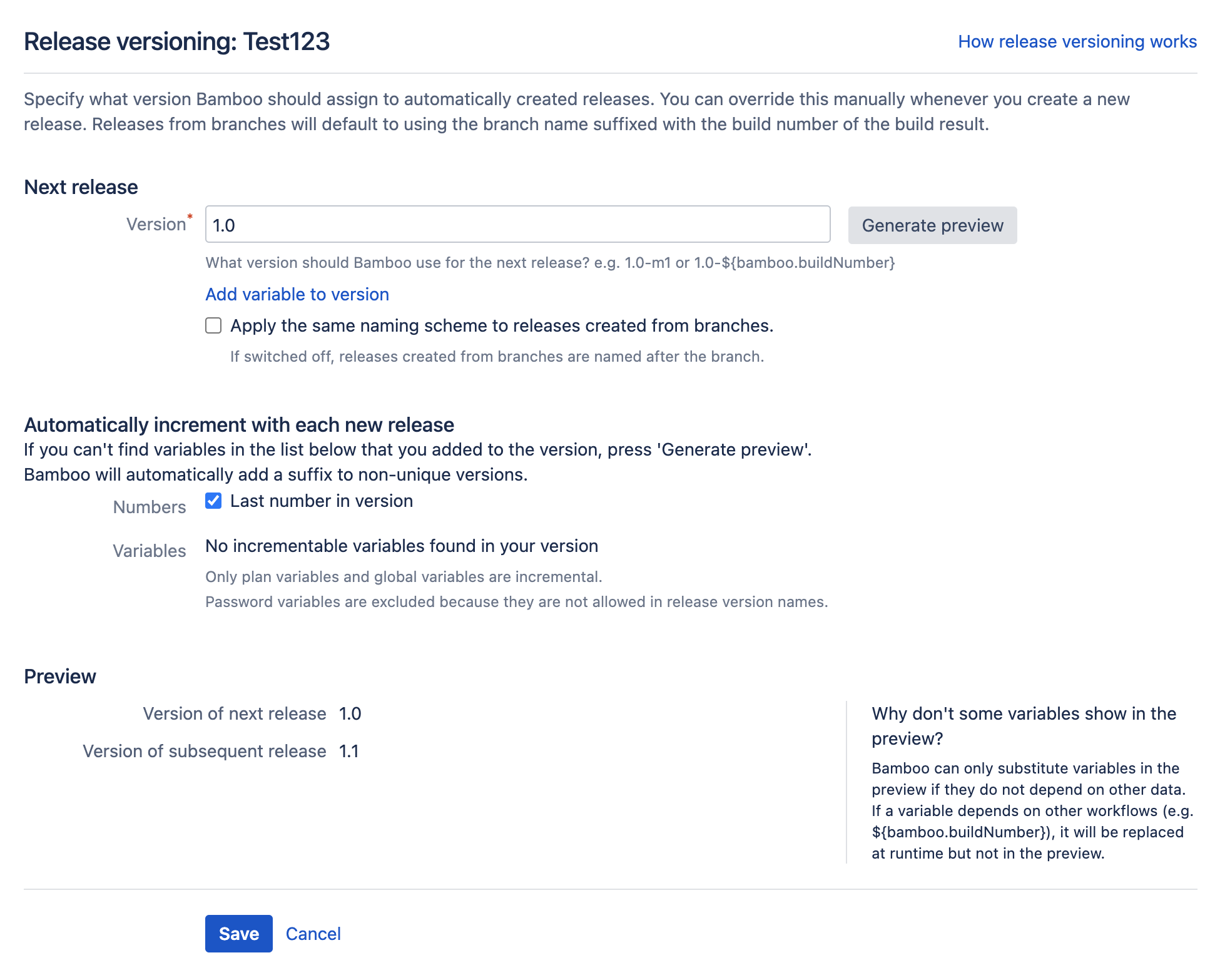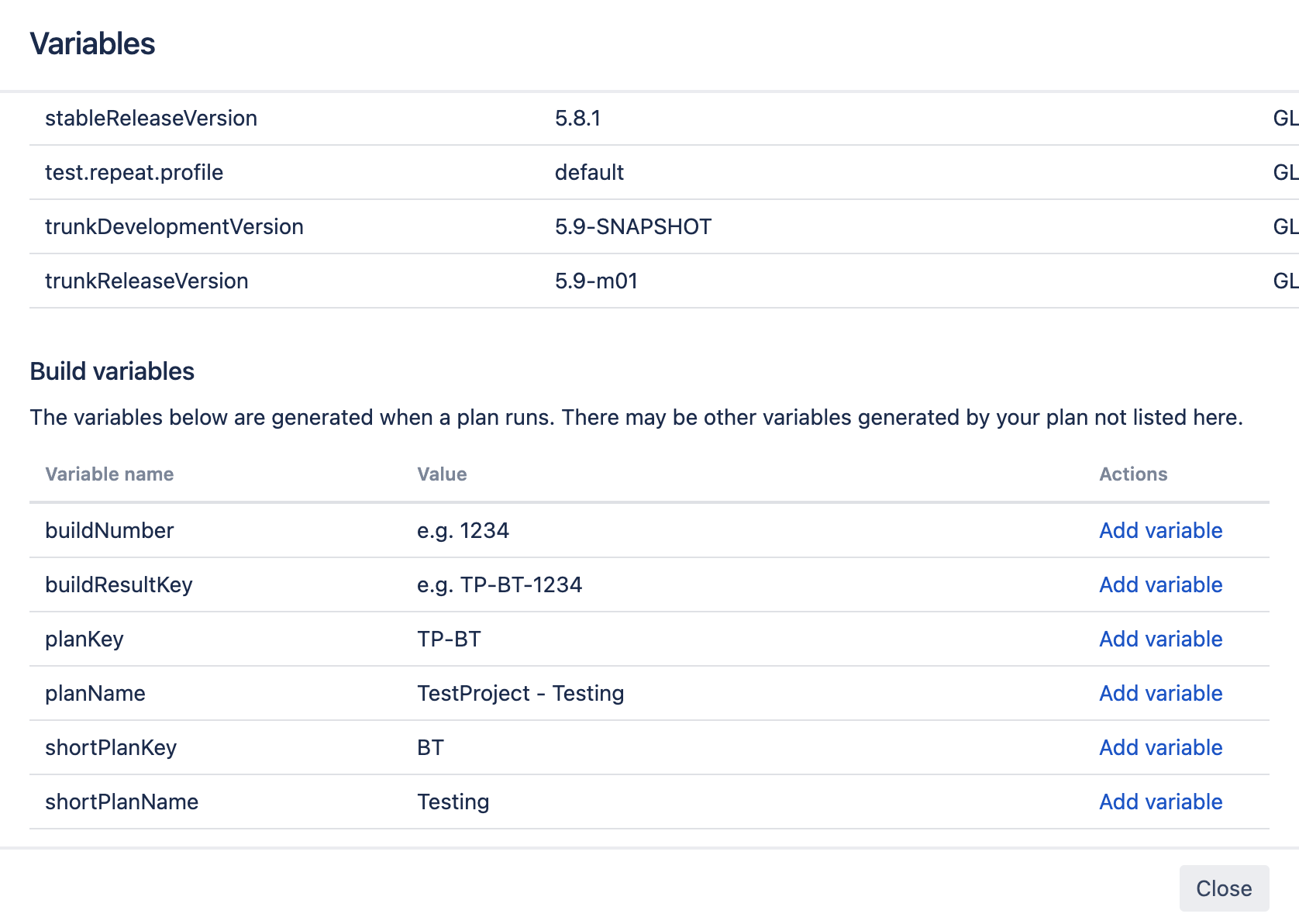Naming versions for deployment releases
Bamboo provides a range of options that allow you to control your release naming scheme. You can specify how Bamboo handles release versioning, and control automatic incrementing between releases.
Bamboo allows you to use:
- Simple incremental numbering
- Advanced numbering based upon Bamboo variables
Bamboo also allows you to manually override automatic release settings when you create a new release.
On this page:
Simple release versioning
Simple release versioning allows you to specify a starting release number, for example, 1.0, which Bamboo will automatically increment. When using simple release versioning, Bamboo will increment the final number in the release name. For example:
| Release name | Incremented release name |
|---|---|
| 1 | 2 |
| 1.1 | 1.2 |
| 1.11 | 1.12 |
| 1.0.1 | 1.0.2 |
To configure simple release naming:
Select Release versioning on the Deployment project configuration screen.
Complete the fields using the following data:
FieldDescriptionOptional?Next release The identification for the next release name that Bamboo will create. In simple release naming, you should use something straightforward like 1.0. If you want the naming scheme for the release to be applied to branches, select Apply the same naming scheme to releases created from branches. Automatically increment with each new release Select the Numbers checkbox to automatically increment the release number according to the Next release field, as defined above. If you leave this box unchecked, no release number incrementing will occur. Preview This field allows you to preview what the next release name will look like. To view the preview, select the Generate preview button.
Note: In some cases, a preview may not be available.
- Select Save.
Release versioning using variables
Release versioning using variables allows you to develop more complex naming schemes, based upon variables set up within Bamboo. You can use global, plan, and build variables in your releasing scheme.
For security reasons, you can't use password variables in version names.
Example
You may have a plan variable called "planvar" with a value of "m6". By including this variable key within the Next release field, Bamboo will automatically add the variable value to the next release name, and increment it accordingly:
| Variable key | Variable value | Next release | Next release version | Subsequent release version |
|---|---|---|---|---|
| planvar | m6 | 1.0-${bamboo.planvar} | 1.0-m6 | 1.1-m7 |
To configure release naming using variables:
- Select the Release versioning button on the Deployment project configuration screen.
Complete the Version field using the following data:
FieldDescriptionOptional?Version The identification for the next release name that Bamboo will create. In simple release versioning, you should use something straightforward like 1.0. - Select the Add variable to version link to display the Variables selection screen:
- Select Add variable to include the variable in your release naming scheme. Then select Close to return to the Release versioning screen.
Complete the remaining fields using the following data:
FieldDescriptionOptional?Automatically increment with each new release 1. Select the Numbers checkbox to automatically increment the release number according to the Next release field, as defined above. If you leave this box unchecked, then no release number incrementing will occur.
2. Select the Variables checkbox to automatically increment selected variable(s) when a new release is created. If matching plan variable exists, its value is incremented, otherwise matching global variable is incremented. Additionally, if a release is created from a branch while the Apply the same naming scheme to releases create from branches option is on, the branch variable is incremented (as long as it exists). Please note, injected variable values (from the Inject Variables task) cannot be automatically incremented using this option.Preview This field allows you to preview what the next release name will look like. To view the preview, select the Generate preview button.
Note: In some cases, a preview may not be available.
- Select Save.
Example release versioning schemes
Bamboo also allows you to use combinations of simple and variable release naming. The following table provides examples of combined naming schemes and demonstrates how careful control of the Numbers and Variables checkboxes can be used to customize your scheme.
| Naming scheme | Next release field | Numbers checkbox | Variables checkbox | Variable value | Next release name | Subsequent release name |
|---|---|---|---|---|---|---|
| Static naming | 1.0 | - | 1.0 | 1.0 | ||
| Naturally unique variable | 1.0-${bamboo.buildNumber} | 13 | 1.0-13 | 1.0-13 | ||
| Number incrementing | 1.0 | - | 1.0 | 1.1 | ||
| Number incrementing + static variable | 1.0-${bamboo.appName} | $ {bamboo.appName} Plan or Global variable: Awesome | 1.0-Awesome | 1.1-Awesome | ||
| Variable incrementing | 1.0-${bamboo.milestone} | $ {bamboo.milestone} Plan or Global variable: m6 | 1.0-m6 | 1.0-m7 | ||
| Number and variable incrementing | 1.0-b${bamboo.appNumber} | ${bamboo.appNumber} User defined variable: 1567 | 1.0-b1567 | 1.1-b1568 |


